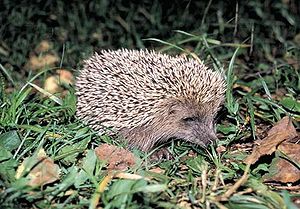Chinese hedgehog
| Chinese hedgehog | ||||||||||||
|---|---|---|---|---|---|---|---|---|---|---|---|---|

Chinese hedgehog ( Erinaceus amurensis ) |
||||||||||||
| Systematics | ||||||||||||
|
||||||||||||
| Scientific name | ||||||||||||
| Erinaceus amurensis | ||||||||||||
| Schrenk , 1859 |
The Chinese hedgehog or Amur hedgehog ( Erinaceus amurensis ) is a species of mammal from the hedgehog family (Erinaceidae). Together with three species living in Europe, the brown-breasted hedgehog , the northern and the southern white-breasted hedgehog , it forms the genus of the small-eared hedgehog ( Erinaceus ).
features
This species is similar in appearance to the hedgehog species that live in Europe, but it is somewhat more rounded. The fur on the underside is also lighter. The top of the head and back are covered with spikes, in the event of an attack it can curl up into a spiked ball. It reaches a head body length of around 28 centimeters and a weight of 1000 grams.
The Chinese hedgehog has a diploid genome of 2n = 48 chromosomes . He has 13 pairs of metacentric , 6 pairs of submetacentric , 3 pairs of subtelocentric and 1 pair of telocentric chromosomes as well as the two sex chromosomes XY.
distribution
Chinese hedgehogs are native to eastern Asia, their distribution area includes the People's Republic of China (from the Yangtze north to Manchuria ) as well as Sichuan , Russia at the mouth of the Amur and the Korean peninsula .
Way of life
Chinese hedgehogs live in diverse habitats such as mixed-tree forests and grasslands, but avoid highland areas, marshland, and agricultural land. They are nocturnal and spend the day in a nest of leaves or grass. Their diet consists mainly of insects and earthworms , less often small vertebrates and fruits. Outside of the mating season, they live solitary.
Systematics
The Chinese hedgehog was first scientifically described in 1859 by Leopold von Schrenck on the basis of an individual from the Amur region near the city of Aigun . According to Wilson & Reeder 2005 it is classified as an independent species in the genus of the small ear hedgehog ( Erinaceus ), which consists of four species; until the end of the 20th century, however, it was considered a subspecies of the brown-breasted hedgehog ( Erinaceus europaeus ).
Threat and protection
The species is classified by the International Union for Conservation of Nature and Natural Resources (IUCN) as not endangered (least concern) due to the size of the population. There are no known threats to the stocks.
supporting documents
- ↑ Feng-Tang Yang, Cai-Xia Ma, Li-Ming Shi: Studies on The Karyotypes of Erinaceus amurensis and Hemiechinus auritus. In: Zoological Research. Vol. 12, No. 4, 1991, ISSN 0254-5853 , pp. 393-398, abstract .
- ↑ a b c d Erinaceus amurensis in the endangered Red List species the IUCN 2011. Posted by: K. Tsytsulina, 2008. Accessed May 22, 2012 found.
- ↑ Erinaceus amurensis ( Memento of the original dated November 9, 2013 in the Internet Archive ) Info: The archive link was inserted automatically and has not yet been checked. Please check the original and archive link according to the instructions and then remove this notice. . In: Don E. Wilson , DeeAnn M. Reeder (Eds.): Mammal Species of the World. A taxonomic and geographic Reference. 2 volumes. 3. Edition. Johns Hopkins University Press, Baltimore MD 2005, ISBN 0-8018-8221-4 .
Web links
- Erinaceus amurensis in the endangered Red List species the IUCN 2011. Posted by: K. Tsytsulina, 2008. Accessed May 22, 2012 found.
